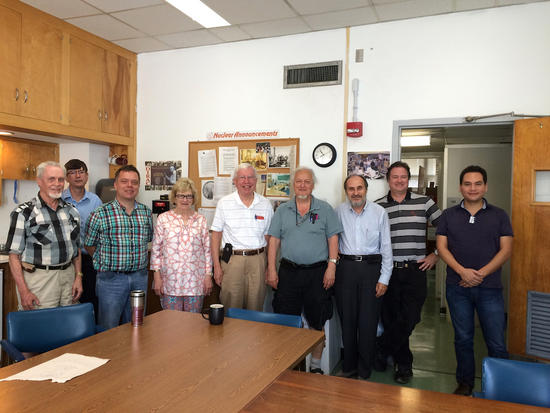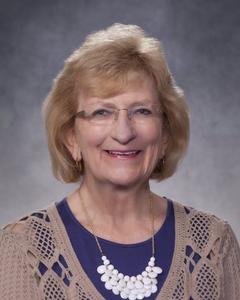FSU alumna Georgiana Fry Vines honored for accomplishments in journalism
Florida State University alumna Georgiana Fry Vines, a pioneer among women journalists and an unwavering supporter of FSU’s physics program, has been honored for a long and extraordinary career. Vines, 76, was recently inducted into the Tennessee Press Association’s 50-Year Club at the group’s summer meeting in Franklin, Tennessee.

Georgiana Fry Vines with faculty members of the FSU Department of Physics
during a recent visit to the department.
Florida State University alumna Georgiana Fry Vines, a pioneer among women journalists and an unwavering supporter of FSU’s physics program, has been honored for a long and extraordinary career. Vines, 76, was recently inducted into the Tennessee Press Association’s 50-Year Club at the group’s summer meeting in Franklin, Tennessee.

Georgiana Fry Vines
“Georgiana’s induction into the Tennessee Press Association’s 50-Year Club is a marvelous recognition of her lifetime of contributions to journalism and is well deserved,” said Mark Riley, FSU’s Robert O. Lawton Distinguished Professor of Physics. “Congratulations on this major achievement award . . . an FSU grad made good for sure!”
Vines, who earned a bachelor’s degree in English from FSU in 1961, credited an earlier Florida State graduate with stoking her passion for journalism.
“When I applied to FSU in 1956-’57, my senior year at South Dade High School (in Homestead, Florida), I intended to become a teacher,” she said. “That year, I took a creative writing course under Dorothy Hood, who had just gotten her master’s in journalism at FSU. The class put out the student newspaper, the Rebel Review. The second semester, I was the editor. I became aware of the influence of journalism, even at the high school level, so when I got to FSU, I decided to major in journalism instead of education.”
What Vines didn’t know was that the state Board of Control, then the governing body for the State University System of Florida, had created a task force to look at where to allocate state money in journalism schools.
“My freshman year, the board made the decision that all state funding would go to the University of Florida,” she said. “I had a year to decide whether to remain at FSU or transfer to Florida. I decided I did not want to become a Gator, so I remained at FSU and became an English major.
“I was not a typical English major, however,” she recalled. “I took a lot of liberal arts classes. In addition, I worked on the Florida Flambeau, which then was a campus publication, for three years and then freelanced for the student magazine my senior year. I also had an opportunity to assist the Orlando Sentinel as a part-time intern during the Florida Legislature my senior year. I felt that the liberal arts courses and experience as a student journalist prepared me for what became a 50-year journalism career starting at The Miami Herald in 1961 after graduating from FSU.”
The world of journalism in the early 1960s didn’t provide nearly as many career opportunities for women as it does now, Vines said. She entered the newspaper business like nearly all of her gender — by taking a job in the women’s department of the Herald.
“That was the only opening for women reporters back then,” she said in an October 2015 interview with the Knoxville (Tennessee) News Sentinel. “On the entire metro staff, there was only one female reporter.”
Fortunately for Vines, a colleague in her hometown of Homestead had to take a leave of absence, and she was assigned to his beat.
“I got to cover the city council, the Everglades, everything in that region,” she recalled. “I realized I would much rather do that than write about women’s clubs.”
She continued to break ground for “girl reporters” — from the Herald to the St. Petersburg Independent to the Milwaukee Sentinel to a public relations firm in Chicago and, in 1968, to the News Sentinel, where she began what would become a more than three-decade tenure in a multitude of roles before retiring as associate editor in 2005. She was gone from Knoxville in 1996-1997 to El Paso, Texas, where she was the editor of the El Paso Herald-Post. When the E.W. Scripps Co. closed the paper due to declining circulation, she returned to Knoxville to continue her career. She still writes political columns twice a week and other stories on assignment.
Vines also ventured into academia. In 2004, she was appointed the Frank Ahlgren Distinguished Lecturer in Journalism and Electronic Media at the University of Tennessee. She has taught public affairs reporting, media management or business journalism classes.
For all of her many journalistic accomplishments, Vines was previously honored with the Lifetime Achievement award by the East Tennessee Writers Hall of Fame in 2015.
In addition to her groundbreaking career as a journalist, Vines is fondly known at Florida State for something else as well — her backing of the Department of Physics.
“I became a supporter of the FSU physics program because I married Dr. John David Fox in 1993,” she explained.
Fox was a longtime professor of physics at FSU who was integral to the development of the university’s nuclear physics program beginning in 1958; he retired after 36 years in 1994. Shortly before his death in 2007, then-FSU President T.K. Wetherell signed papers renaming the Physics Laboratory the John D. Fox Superconducting Linear Accelerator Laboratory.
“We had met my senior year at FSU through mutual friends,” Fox said of her late husband. “Our paths crossed again after I came to Knoxville in 1968 to work for the Knoxville News Sentinel and he was doing research at Oak Ridge National Laboratory. Both of our personal lives changed through the years, and eventually we had a commuter marriage. After he retired from FSU in 1994, he moved to Knoxville, where he continued to do research at Oak Ridge. I admit I don't understand physics, because I never took one course, but he would explain to me about his work and his eyes lit up. I knew it was important. I’m glad to help support the department, because I know he spent the bulk of his career there and it was important to him.”
One of John Fox’s longtime colleagues and close friends at FSU offered high praise for the late professor, who died in 2007, as well as for his wife.
“John D. Fox helped vault FSU into the premier league of nuclear physics worldwide and transformed our accelerator laboratory into what it is today,” said Professor of Physics Emeritus Kirby Kemper. “Georgiana has been a most wonderful supporter of the physics program since his passing, and she still regularly pops in for a visit. In addition, the top floor of the Keen Building was transformed thanks to her help. Its centerpiece is the Kemper-Fox Seminar Room.”
Kemper said Fox’s enthusiasm for physics research “attracted an outstanding group of graduate students who are now amongst today’s nuclear physics leaders in the U.S. In addition, he mentored two generations of faculty members who have continued the excellence in physics research at Florida State that he established.”

